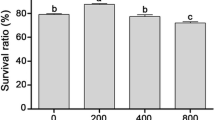Abstract
The dhlA gene of Xanthobacter autotrophicus encodes dehalogenase that hydrolyzes dihaloalkanes such as 1,2-dichloroethane (DCE) into cytotoxic halogenated alcohol and an inorganic halide. As plants do not contain dehalogenase activity, they grow normally in the presence of DCE. We tested the transgenic expression of the bacterial dhlA gene in rice as a conditional negative selection marker. We developed 24 transgenic callus lines containing dhlA gene driven by rice actin-1 promoter, verified the expression of dhlA by Northern blot analysis, and subjected these transgenic lines to DCE treatment. We found that, while untransformed callus (Nipponbare) was unaffected by the DCE treatment, most of the transformed lines displayed symptoms of toxicity, indicating that dhlA is an effective conditional negative selection marker gene for rice in vitro cultures.


Similar content being viewed by others
References
Breitler J. C.; Meynard D.; Van Boxtel J.; Royer M.; Bonnot F.; Cambillau L.; Guiderdoni E. A novel two T-DNA binary vector allows efficient generation of marker-free transgenic plants in three elite cultivars of rice (Oryza sativa L.). Transgenic Res. 13: 271–287; 2004.
Chu C. C.; Wang C. C.; Sun C. S.; Hsu C.; Yin K. C.; Chu C. Y.; Bi F. Y. Establishment of an efficient medium for anther culture of rice through comparative experiments on the nitrogen sources. Sci. Sin. 18: 659–668; 1975.
Cuellar W.; Gaudin A.; Solorzano D.; Casas A.; Nopo L.; Chudalayandi P.; Medrano G.; Kreuze J.; Ghishlain M. Self-excision of the antibiotic resistance gene nptII using a heat inducible Cre-loxP system from transgenic potato. Plant Mol. Biol. 62: 71–82; 2006.
Depicker A. G.; Jacobs A. M.; Van Montagu M. C. A negative selection scheme for tobacco protoplast-derived cells expressing the T-DNA gene 2. Plant Cell Rep. 7: 63–66; 1988.
Erikson O.; Hertzberg M.; Näsholm T. A conditional marker gene allowing both positive and negative selection in plants. Nat. Biotechnol. 22: 455–458; 2004.
Gleave A. P.; Mitra D. S.; Mudge S. R.; Morris B. A. Selectable marker-free transgenic plants without sexual crossing: transient expression of cre recombinase and use of a conditional lethal dominant gene. Plant Mol. Biol. 40: 223–235; 1999.
Hiei Y.; Ohta S.; Komari T.; Kumashiro T. Efficient transformation of rice (Oryza sativa L.) mediated by Agrobacterium and sequence analysis of the boundaries of the T-DNA. Plant J 6: 271–282; 1994.
Hoff T.; Schnorr K. M.; Mundy J. A recombinase-mediated transcriptional induction system in transgenic plants. Plant Mol. Biol. 45: 41–49; 2001.
Janssen D. B.; Pries F.; van der Ploeg J. R. Genetics and biochemistry of dehalogenating compounds. Ann. Rev. Microbiol. 48: 163–191; 1994.
Komari T.; Hiei Y.; Saito Y.; Murai N.; Kumashiro T. Vectors carrying two separate T-DNAs for co-transformation of higher plants mediated by Agrobacterium tumefaciens and segregation of transformants free from selection markers. Plant J. 10: 165–174; 1996.
Kondrak M.; van der Meer I. M.; Banfalvi Z. Generation of marker- and backbone-free transgenic potatoes by site-specific recombination and a bi-functional marker gene in a non-regular one-border Agrobacterium transformation vector. Transgenic Res. 15: 729–37; 2006.
Koukalova B.; Fojtova M.; Lim K. Y.; Fulnecek J.; Leitch A. R.; Kovarik A. Dedifferentiation of tobacco cells is associated with ribosomal RNA gene hypomethylation, increased transcription, and chromatin alterations. Plant Physiol. 139: 275–86; 2005.
McElroy D.; Blowers A. D.; Jenes B.; Wu R. Construction of expression vectors based on the rice actin 1 (Act1) 5¢ region for use in monocot transformation. Mol. Gen. Genet. 231: 150–60; 1991.
Murray M. G.; Thompson W. F. Rapid isolation of high molecular weight plant DNA. Nucleic Acids Res 8: 4321–4325; 1980.
Naested H.; Fennema M.; Hao L.; Andersen M.; Janssen D. B.; Mundy J. A bacterial haloalkane dehalogenase gene as a negative selectable marker in Arabidopsis. Plant J. 18: 571–576; 1999.
Olhoft P. M.; Phillips R. L. Genetic and epigenetic instability in tissue culture and regenerated progenies. In: LernerH. R. (ed) Plant responses to environmental stresses: From phytohormones to genome reorganization. Marcel Dekker, New York, pp 111–148; 1999.
Pawlowski W. P.; Somers D. A. Transgenic DNA integrated into the oat genome is frequently interspersed by host DNA. Proc. Natl. Acad. Sci. U.S.A. 95: 12106–12110; 1998.
Risseeuw E.; Franke-van Dijk M. E.; Hooykaas P. J. Gene targeting and instability of Agrobacterium T-DNA loci in the plant genome. Plant J. 11: 717–728; 1997.
Scutt C. P.; Zubko E.; Meyer P. Techniques for the removal of marker genes from transgenic plants. Biochimie 84: 1119–1126; 2002.
Serino G.; Maliga P. A negative selection scheme based on the expression of cytosine deaminase in plastids. Plant J. 12: 697–701; 1997.
Srivastava V.; Ow D. W. Biolistic mediated site-specific integration in rice. Mol. Breed 8: 345–350; 2002.
Srivastava V.; Ow D. W. Marker-free site-specific gene integration in plants. Trends Biotechnol. 22: 627–629; 2004.
Stougaard J. Substrate-dependent negative selection in plants using a bacterial cytosine deaminase gene. Plant J. 3: 755–761; 1993.
Zhang W.; Subbarao S.; Addae P.; Shen A.; Armstrong C.; Peschke V.; Gilbertson L. Cre/lox-mediated marker gene excision in transgenic maize (Zea mays L.) plants. Theor. Appl. Genet. 107: 1157–1168; 2003.
Zuo J.; Niu Q. W.; Moller S. G.; Chua N. H. Chemical-regulated, site-specific DNA excision in transgenic plants. Nat. Biotechnol. 19: 157–161; 2001.
Acknowledgments
This work was supported by funds received from USDA–CSREES and Division of Agriculture, University of Arkansas. The dhlA gene was obtained from David W. Ow.
Author information
Authors and Affiliations
Corresponding author
Additional information
Editor: Gregory C. Phillips
Rights and permissions
About this article
Cite this article
Moore, S.K., Srivastava, V. A bacterial haloalkane dehalogenase (dhlA) gene as conditional negative selection marker for rice callus cells. In Vitro Cell.Dev.Biol.-Plant 44, 468–473 (2008). https://doi.org/10.1007/s11627-008-9144-z
Received:
Accepted:
Published:
Issue Date:
DOI: https://doi.org/10.1007/s11627-008-9144-z




